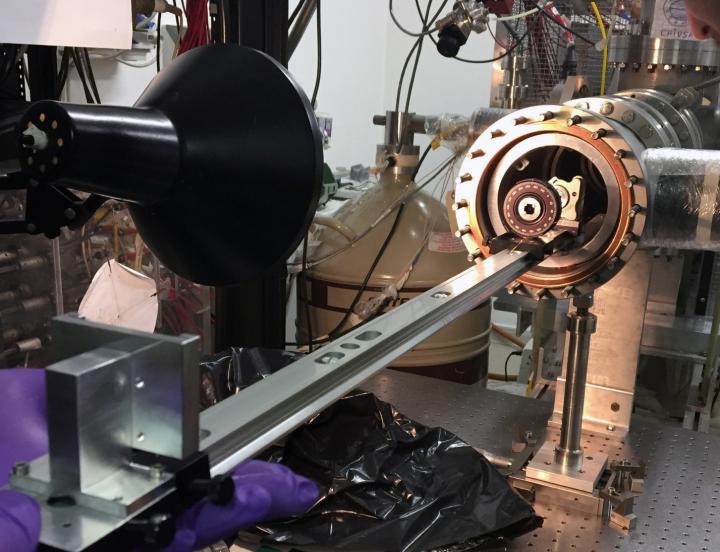May 6 2019
As part of an interference experiment, an international research team, including researchers from the University of Bern, has shown for the first time that antimatter particles not just have the properties of particles but also behave as waves. The success of this study opens the door to an innovative field of antimatter analyses.
 The Talbot-Lau interferometer of the QUPLAS collaboration at the Positron Laboratory of the Politecnico di Milano in Como. (Image credit: © LHEP/AEC, University of Bern)
The Talbot-Lau interferometer of the QUPLAS collaboration at the Positron Laboratory of the Politecnico di Milano in Como. (Image credit: © LHEP/AEC, University of Bern)
One of the important features of quantum mechanics is matter waves in which particles exhibit wave-like properties besides particle characteristics. Louis de Broglie, a French physicist, hypothesized this wave-particle duality as early as 1924.
Several experiments with neutrons and electrons, and also with more complex matter up to large molecules, have successfully revealed the occurrence of the wave property of matter. The wave-particle duality of antimatter had also been established using diffraction experiments.
But scientists at the QUPLAS collaboration have now demonstrated the wave behavior in a single positron (antiparticle to the electron) interference experiment. The study outcomes have been published in the Science Advances journal.
An Experiment Already Envisaged by Einstein
Researchers from the University of Bern and from the University and Politecnico of Milano are part of the QUPLAS scientific collaboration. They established the wave-particle duality of single positrons by carrying out measurements using a setup analogous to what is called the double-slit experiment. Famous physicists like Albert Einstein and Richard Feynman already proposed this setup to be a gedankenexperiment; it is usually used in quantum theory to show the wave nature of particles.
The experiment involves directing particles (here positrons) from a source to a position-sensitive detector. Between the source and the detector, gratings with patterns of two or more slits are positioned. The particles travel through these gratings. Particles that behave similarly to particles would travel in straight lines and would generate a pattern corresponding precisely to the grating. If the nature of the particles is wave-like, a striped interference pattern is produced at the detector, which is different from the grating. The new pattern is produced by the superposition of the waves discharged by the source and traveling through the grating.
Micrometric Resolution
The QUPLAS collaboration researchers could produce, for the first time, such an interference pattern from single antimatter particle waves. It was achieved with the help of a novel period-magnifying Talbot-Lau interferometer coupled to a nuclear emulsion position-sensitive detector.
With the nuclear emulsions we are able to determine the impact point of individual positrons very precisely which allows us to reconstruct their interferometric pattern with micrometric accuracy - thus to better than millionth of a meter.
Dr Ciro Pistillo, Laboratory of High Energy Physics (LHEP) and Albert Einstein Center (AEC), University of Bern
This feature enabled the scientists to resolve two of the main drawbacks of antimatter experiments—beam manipulation complexity and low antiparticle flux.
The researchers at LHEP and AEC has a vital role to play for the successful completion of the project: Akitaka Ariga, Antonio Ereditato, Ciro Pistillo, and Paola Scampoli were specifically responsible for the design, construction, and operations of the emulsion detector as well as for the investigation of positron interaction data.
New Field of Investigations of Antimatter
Our observation of the energy dependence of interference pattern proves its quantum-mechanical origin and thus the wave nature of the positrons.
Paola Scampoli, Professor, University of Bern
The experiment’s success opens the door to a new field of analyses based on antimatter interferometry. For instance, one of the aims is to conduct gravity measurements using exotic matter-antimatter symmetric atoms like positronium.
Using this, the validity of the Weak Equivalence Principle for antimatter can be tested. This principle is the underlying principle for general relativity and has never been investigated with antimatter. In the future, futuristic research fields that are based on antimatter interferometry could offer information related to the imbalance of matter and antimatter in the universe.